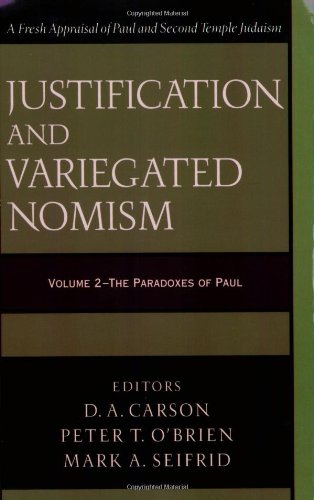A Brief Book Summary from Books At a Glance
By Nathan Sundt
About the Author
Douglas Moo is Blanchard Professor of New Testament, Wheaton College Graduate School
Summary
Douglas Moo notes at the beginning of the essay how the New Perspective spawned a series of re-readings that pertain to the fundamental axes of Pauline thought. N. T. Wright and James Dunn “are the best representatives of the “New Perspective,” and both have written commentaries on Romans, the book with which this essay deals” (185). Thus, Moo intends to mix the broad and the narrow: to gloss broad Pauline themes in a narrow slice of literature—Romans 5-11 (yet a section itself famous for its broad themes!). He further notes how New Perspective readings have failed to speak with one voice positively and yet have, with one voice, negatively denounced a certain “Lutheran” treatment that conceived Paul’s concerns only on a vertical axis; New Perspective writers with their focus on covenant badges emphasize a more “horizontal orientation” (186). The focus is not so much merely on individual transformation “from sinner to saint” but about the “integration of Gentiles into the people of God” (186). The traditional interpretation, therefore, has a wrong dichotomy in Paul’s law concept: human doing vs. human believing. New Perspective advocates claim that the dichotomy is more like covenant identification vs. new covenant faith (186). New Perspective advocates claim that Paul’s problem is not that his interlocutors are trying to perform the law but that they are trying to possess it—as a special privilege and medium of access to the one, true God. Moo will turn and critique the New Perspective but first registers his “own appreciation for many of the emphases that this new approach has brought to light” (188). These emphases include the importance of the gospel’s social effects and the formation of a new “people” to be God’s special possession. He turns to argue, however, that precisely in negating—rather than supplementing—the traditional Reformation interpretation, the New Perspective has laid itself on too thin of a basis.
Moo sets Romans 5-8 within the breadth of the letter. “Most commentators now agree that a shift of focus occurs at 5:1” (189). Romans 5 itself emphasizes how Christ’s work negates Adam’s sin. “Having set forth his initial case for Christian assurance, Paul in chs. 6 and 7 deals with possible objections to his argument: sin and the law” (190). Romans 7 addresses how the law could have such a dark character but its transition into chapter 8 demonstrates how its ruthless condemnation of sin serves the Gospel. In chapter 8, the gospel truly becomes “the power of God for salvation” as the work of the Spirit releases the sinner from bondage and guarantees final, climactic, salvation. Having listed these elements, Moo arrives at one of his central claims: “the focus of these chapters is not on the “people” issue of Jews and Gentiles. The chapters of course have implications for the corporate body of believers in Christ; but it appears to be the human being turned believer, without reference to ethnic or national background, that is Paul’s concern throughout. This focus raises questions about the degree to which an ethnocentric reading of Romans can successfully accommodate these chapters” (192).
Moo offers a caveat: “the best representatives of the New Perspective, such as Dunn and Wright, do not deny that the individual human being figures importantly in Romans.… But I am not sure that they are successful in integrating the individual orientation of chs. 5–8 into their reading of Romans, which makes the inclusion of Gentiles the dominant element in the argument” (192).
Moo admits the data that New Perspective writers claim, namely, that Paul’s references to “law” are not to some kind of law-in-general but to the Torah in particular. Moo however integrates this point in a model that also takes seriously the individuality of these chapters: “But these references do not function to distinguish Jews from Gentiles but to illustrate the general human condition that interaction with God‘s law reveals” (192–193). Moo references the treatment of N. T. Wright very similarly, who argues to the effect that Romans 5–8 is patterned after the story of Israel—the redemption language alluding to the Exodus, the treatment of baptism eluding to. . .
[To continue reading this summary, please see below....]The remainder of this article is premium content. Become a member to continue reading.
Already have an account? Sign In
Buy the books

JUSTIFICATION AND VARIEGATED NOMISM (VOLUME 2): PARADOXES OF PAUL, edited by D. A. Carson, Peter T. O'Brien, and Mark A. Seifrid